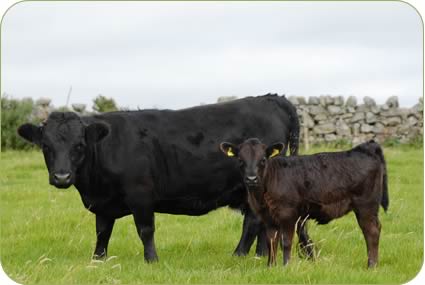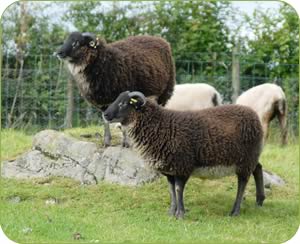Jennifer MacKenzie is an agricultural photo journalist with almost 30 year's experience. Operating from her base in Cumbria, Jennifer undertakes mainly industry-related freelance writing and photography.
Naturally-reared Passion
A passion for naturally-reared, quality food and the desire to share that with others has led Jo Kemp to produce her own traditional beef and lamb.
Jo and her husband Nick began breeding Shetland sheep eight years ago at Breoch Park, New Abbey, near Dumfries.
 |
| Nick and Jo Kemp with Shetland sheep |
A year later the foundation females arrived on the 50-acre holding for their Dexter herd, Jo achieving the long-held ambition of her late father to run the small, hardy breed which are believed to be descended from the native black Celtic cattle of old.
“I had been interested in the Dexter for a long time before I started the herd,” said Jo.
“The plus-points for this little breed are that it’s hardy and can live out all the time. It doesn’t damage the ground in the way other heavier breeds do and the food value of the meat is superb.
“They don’t need extra feeding which saves on the price of grain which is increasing. This actually improves the fat content when just grazed on grass and haylage. They are reared in a very traditional way,” she added.
A few foundation females were bought from Veronica Scholfield’s Harron herd at Ivegill, near Carlisle but Jo decided to close the herd after foot and mouth, during which time she lost the Shetland sheep in the cull, because of further disease threats, particularly TB.
The Breoch herd now numbers 26 head which includes nine breeding females. Flying the breed and the Breoch flag, Jo took the male championship at this year’s Great Yorkshire Show with her five and a half year old stock bull Breoch Sultan, out of one of the original Harron cows, Sunbeam, and by the AI bull Apple Joe.
Other AI bulls used recently are Moomin Jupiter and Copthorne Danny Boy.
Jo aims to breed a ‘genuine small cow’ and, since the dwarfing gene has been identified she, like other breeders, is avoiding those with the gene. Thus the likelihood of a bulldog calf is now vastly reduced.
By selective breeding she plans to increase breeding female numbers to around 30 so that she can meet the needs of an increasing demand for Dexter beef in the area.
Joe and breeders of three other traditional beef cattle – Longhorn, Highland and Belted Galloway – have joined forces under the banner of Solway Natives to market their produce through direct sales.
With current constraints on their individual production, working together gives greater scale and continuity of supply for their customers, as well as saving on costs.
 |
| Dexter cow and calf |
All the Dexter beef is hung for a minimum of three weeks, if not four, by a local butcher before being cut and vacuum packed, most selling chilled although there is a supply from the freezer. Carcases typically weight 200 to 210kg and they aim to butcher half a dozen a year.
Cattle for rib and other on the bone joints have to be finished before 24 months old which they are able to do easily, unlike some other native breeds. Beef as old as 40 months when killed has produced tender, well-marbled meat and Dexter beef is renowned for its quality and flavour
Commercial farmers are put off Dexter cattle and Shetland sheep owing to their small size but Jo has been trying to persuade them that it makes commercial sense to use the breed as a suckler cow.
“Like the Shetland sheep, the Dexter because of its pelvis has the ability to produce a big calf such as by a Limousin bull. They are a dual purpose animal and have plenty of milk and some breeders buy an extra calf and double-suckle them,” she said.
At around half the weight of continental type suckler cows, they require half the grazing as well as few inputs.
While the number of Dexter breeding cows in 2005 came to more than 5,000 in the UK, the Shetland sheep are more rare, with 1,570 lambs reared in 2006 from 1,266 breeding females.
Jo and Nick are breeding their sheep for the meat and the wool. The meat is more difficult to market than the Dexter beef but around 35 lambs are finished each year. More recently they have sold mutton which has proved popular. Carcase weights for the sheep are between 12kg and 18kg.
Unlike the more commercial type of white-woolled sheep kept on the breed’s native Shetland, Jo is breeding a flock with a diversity of colourings.
 |
| Shetland ram lambs in one of the colour markings Jo favours |
While white is the preferred fleece colour for the British Wool Marketing Board which can earn up to £1 a kg, breeders are trying to set up a marketing campaign under licence from the board with a mill in Yorkshire which will add value to the coloured wool, hopefully earning around £5 a kg.
“Breeding and producing our own meat gives us a better quality of life and I’m trying to send out a message to people,” said Jo.
“It’s an extensive system but you can run more cattle on the same acreage and the cows and sheep can be producing well into their teens. They are easier managed which is important these days when people can’t afford to employ staff. It’s all down to economics in the end,” she added.
